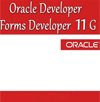Admission
Forms Developer Support Engineer
Oracle Forms Developer 10g: Build Internet Applications
| Exam # |
Duration |
Language |
Level |
Type |
Classroom |
Code |
Fees |
|
-- |
42 |
English |
Professional |
Course |
Classroom |
Cs411 |
0 LE |
Description :
In this course, you will build, test and deploy Internet applications with Oracle Forms. Working in a graphical user interface (GUI) environment, you learn how to build forms with user input items such as check boxes, list items, and radio groups. You will also display Form elements in multiple windows and customize data access by creating event-related triggers.
Objectives :
-
Create form modules, including components for database interaction and GUI controls
-
Link one form module to another
-
Implement triggers
-
Debug form modules in a 3-tier environment
-
Test form modules in a Web browser
-
Reuse objects and code
-
Display form modules in multiple windows and use a variety of layout styles.
Topics :
Introducing Oracle Forms Developer and Forms Services
-
Grid Computing
-
Oracle 10g Products
-
Oracle Application Server Architecture
-
Oracle Forms Services Architecture
-
Benefits and Components of Oracle Developer Suite
-
Running a Forms Developer Application
-
Working in the Forms Developer Environment
Creating Forms Modules
-
Creating a Basic Forms Module
-
Creating a Master-Detail Forms Module
-
Modifying the Data Block
-
Modifying the Layout
Working with Data Blocks and Frames
-
Using the Property Palette
-
Managing Object Properties
-
Creating and Using Visual Attributes
-
Controlling the Behavior and Appearance of Data Blocks
-
Controlling Frame Properties
-
Creating Control Blocks
-
Deleting Data Blocks
Working with Input Items
-
Creating Text Items
-
Controlling the Behavior and Appearance of Text Items
-
Creating LOVs
-
Defining Editors
-
Creating Check Boxes
-
Creating List Items
-
Creating Radio Groups
Working with Non input Items
-
Creating a Display Item
-
Creating an Image Item
-
Creating a Push Button
-
Creating a Calculated Item
-
Creating a Hierarchical Tree Item
-
Creating a Bean Area Item
Creating Windows and Canvases
-
Overview of Windows and Canvases
-
Displaying a Form Module in Multiple Windows
-
Creating a New Window
-
Displaying a Form Module on Multiple Layouts
-
Creating a New Content Canvas
-
Creating a Stacked Canvas
-
Creating a Toolbar
-
Creating a Tab Canvas
Producing Triggers
-
Grouping Triggers into Categories
-
Defining Trigger Components: Type, Code, and Scope
-
Specifying Execution Hierarchy
-
Using the PL/SQL Editor
-
Using the Database Trigger Editor
-
Writing Trigger Code
-
Using Variables and Built-ins
-
Using the When-Button-Pressed and When-Window-Closed Triggers
Debugging Triggers
-
The Debugging Process
-
The Debug Console
-
Setting Breakpoints
-
Debugging Tips
-
Running a Form in Debug Mode
-
Stepping through Code
Adding Functionality to Items
-
Coding Item Interaction Triggers
-
Defining Functionality for Check Boxes
-
Changing List Items at Run Time
-
Displaying LOVs from Buttons
-
Populating Image Items
-
Populating and Displaying Hierarchical Trees
-
Interacting with JavaBeans
Run-Time Messages and Alerts
-
Built-Ins and Handling Errors
-
Controlling System Messages
-
The FORM_TRIGGER_FAILURE Exception
-
Using Triggers to Intercept System Messages
-
Creating and Controlling Alerts
-
Handling Server Errors
Query Triggers
-
Handling Server Errors
-
SELECT Statements Issued During Query Processing
-
WHERE and ORDER BY clauses and the ONETIME_WHERE property
-
Writing Query Triggers
-
Query Array Processing
-
Coding Triggers for Enter-Query Mode
-
Overriding Default Query Processing
-
Obtaining Query Information at Run Time
Validation
-
Validation Process
-
Controlling Validation Using Properties
-
Controlling Validation Using Triggers
-
Performing Client-Side Validation with PJCs
-
Tracking Validation Status
-
Using Built-ins to Control When Validation Occurs
Navigation
-
Navigation Overview
-
Understanding Internal Navigation
-
Using Object Properties to Control Navigation
-
Writing Navigation Triggers: When-New--Instance, Pre- and Post- Triggers
-
The Navigation Trap
-
Using Navigation Built-Ins in Triggers
Transaction Processing
-
The Commit Sequence of Events
-
Characteristics and Common Uses of Commit Triggers
-
Testing the Results of Trigger DML
-
DML Statements Issued during Commit Processing
-
Overriding Default Transaction Processing
-
Running against Data Sources Other Than Oracle
-
Getting and Setting the Commit Status
-
Implementing Array DML
Writing Flexible Code
-
What is Flexible Code?
-
Using System Variables for Flexible Coding
-
Using Built-in Subprograms for Flexible Coding
-
Referencing Objects by Internal ID
-
Referencing Items Indirectly
Sharing Objects and Code
-
Benefits of Reusable Objects and Code
-
Working with Property Classes
-
Working with Object Groups
-
Copying and Subclassing Objects and Code
-
Working with Object Libraries
-
Working with SmartClasses
-
Reusing PL/SQL
-
Working with PL/SQL Libraries
Using WebUtil to Interact with the Client
-
Benefits of WebUtil
-
Integrating WebUtil into a Form
-
Interacting with the Client
Introducing Multiple Form Applications
-
Multiple Form Applications Overview
-
Starting Another Form Module
-
Defining Multiple Form Functionality
-
Sharing Data among Modules
Recommended Knowledge :
Oracle Database 10g: Program with PL/SQL. Oracle Database 10g: SQL and PL/SQL Fundamentals.
Recommended Course(s) :
|
Oracle Database 10g: Introduction to SQL |
|
Oracle Database 10g: Program with PL/SQL |
Training Materials :
Oracle Press
Labs :
This course includes several labs to ensure you will gain the targeted skills and experience.
Credential :
This course is an essential part of ORACLE10g Forms Developer Certified Professional (OCP)
Category :
DataBase
The Instructor:
